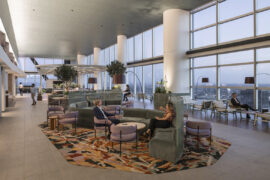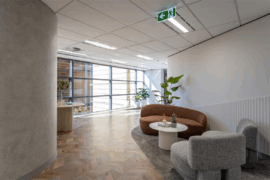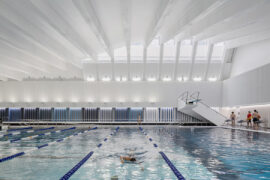With the age of the digital nomad and gig economy now in full swing, we explore how these cultural phenomena are driving specification.

In 2018, the face of the itinerant worker is a far cry from the nomadic workers of the past who travelled from farm to farm in search of gruelling, often low-paying manual work. The new generation of itinerant workers are nomads too, albeit of the digital age, moving from workspace to workspace to pursue (often lucrative) freelance careers.
Today, they’re designers, strategists, consultants – white-collar movers and shakers with big ideas and the skills to match. Welcome to the age of the gig economy.
Around the world, employers are increasingly hiring freelancers on a short-term project – or ‘gig’ – basis as a response to increased pressure to meet bottom lines. In the face of budget constraints, tight timelines, and a culture that prizes efficiency, freelancers give employers valuable flexibility to expand and contract their workforce according to need.
The appeal of this is undeniable, with a 2017 survey by MYOB finding that 89% of business respondents had used a freelancer within the six months prior to the survey and were likely to do so again.
The rise of the gig economy has not only radicalised workplace culture – it has also affected the very face and nature of workplaces themselves. In turn, this begs the question of how to design for a workforce that is, by its nature, essentially a revolving door. Below, we address this critical question and provide a crash course in designing for a new generation of itinerant workers.
As freelancers are constantly moving from workplace to workplace, they typically lack the stabilising elements that many permanent employees take for granted: a desk to call their own, a company or brand to identify with, and a sense of ownership over their space in the workplace. One way to provide this stability is by crafting a strongly branded experience akin to that of the INDE Award-nominated co-working space, The Working Capital @ Robinson.
Spaces with a strong sense of identity – crafted through consistent, well-considered design and specification – can help freelancers feel tethered to a space by providing predictability and familiarity, two things that are often lacking within the gig economy. This feeling of belonging, in turn, can drive positive freelancing experiences and encourage repeat visits to your co-working space.
Flexibility is the backbone of freelance work, so it’s only fitting that this is reflected in the design of co-working spaces. A top-down design approach is helpful in this regard: consider how everything from the floor plan to fit out and furniture can be optimised to deliver flexibility.
Think creatively: in this context, flexibility can mean anything from providing a variety of separate spaces that enable different work styles to crafting multipurpose spaces that can easily be transformed to serve multiple functions.
For furniture, this could mean specifying products that grow with the team – for example, modular furniture – or can be adjusted to suit individual worker preferences (think: sit to stand desks, adjustable chairs).
The freelance workforce is a diverse bunch. Though a recent US survey by Xero showed that the freelancer demographic skews young – with 45 per cent being between 18 and 34 years of age, 37 per cent being between 35 and 50, and 18 per cent being over 50 – it also noted that freelancing is on the rise for males and females in urban and suburban areas alike.
The rise of online freelancing platforms has opened the freelance market up to people of all backgrounds and demographics, and it is critical that co-working spaces are designed to accommodate this diversity.
As such, ensure that your co-working space caters for a broad range of users and account for disability access and a breadth of generations, genders, and cultural backgrounds. This can be achieved by specifying adjustable furniture and fit out, ensuring accessibility measures, and leveraging technology to create a clear, easy to understand user experience.
It’s an established fact that diversity sparks creativity: ensuring that all users feel welcome and at home in your space is central to creating a positive, inclusive environment.
Freelancers may not work your average 9 to 5, but this doesn’t mean they’re working any less than your average desk dweller: freelancers tend to work between 30 to 50 hours a week and typically work on up to 3 projects at once.
And because they’re more likely to work on the go and outside of office hours, freelancers are more prone than permanent employees to suffer from a work-life imbalance.
In light of this, it is critical that your co-working space encourages productivity while at work in addition to a life outside of work. Think carefully about amenities and the messages that these send to employees: break out spaces? Showers for those who cycle in or workout at lunch? Great. Nap pods? A breakfast bar?
Consider whether the implications of these – that people should remain at work even when sleep deprived, and should come in before office hours – align with your brand and encourage healthy work practices.
It’s advisable to approach amenities strategically and work out whether they are consistent with the kind of message and workplace culture that you want to set.
Coming to Sydney’s Carriageworks this 9 – 10 August, FRONT takes on the biggest questions facing contemporary commercial design. To learn more about changing work cultures, the future of workplace design, and what it all means for you, get on board with this industry-leading event today.
The commercial sector is evolving and the way that you design needs to, too. Get the industry knowledge and connections that you need today to get ahead of the industry of tomorrow at FRONT this 9 – 10 August.
INDESIGN is on instagram
Follow @indesignlive
A searchable and comprehensive guide for specifying leading products and their suppliers
Keep up to date with the latest and greatest from our industry BFF's!

CDK Stone’s Natasha Stengos takes us through its Alexandria Selection Centre, where stone choice becomes a sensory experience – from curated spaces, crafted details and a colour-organised selection floor.

In an industry where design intent is often diluted by value management and procurement pressures, Klaro Industrial Design positions manufacturing as a creative ally – allowing commercial interior designers to deliver unique pieces aligned to the project’s original vision.

Designed by Woods Bagot, the new fit-out of a major resources company transforms 40,000-square-metres across 19 levels into interconnected villages that celebrate Western Australia’s diverse terrain.

In an industry where design intent is often diluted by value management and procurement pressures, Klaro Industrial Design positions manufacturing as a creative ally – allowing commercial interior designers to deliver unique pieces aligned to the project’s original vision.
The internet never sleeps! Here's the stuff you might have missed

A thoughtful, low-waste redesign by PMG Group in collaboration with Goodman has transformed a dated office into a calm, contemporary workspace featuring a coastal-inspired palette and Milliken flooring for a refined finish.

At Melbourne Design Week, Plus Studio brought together planners, designers and local government voices to unpack the realities of urban densification.

Hiwa, the University of Auckland’s six-storey recreation centre by Warren and Mahoney with MJMA Toronto and Haumi, has taken out Sport Architecture at the 2025 World Architecture Festival. A vertical village for wellbeing and connection, the project continues its run of global accolades as a new benchmark for campus life and student experience.

BLP’s new Sydney Children’s Hospital, Randwick building brings together paediatric care, family-centred design and Australia’s first Children’s Comprehensive Cancer Centre in a major addition to the Randwick Health & Innovation Precinct.